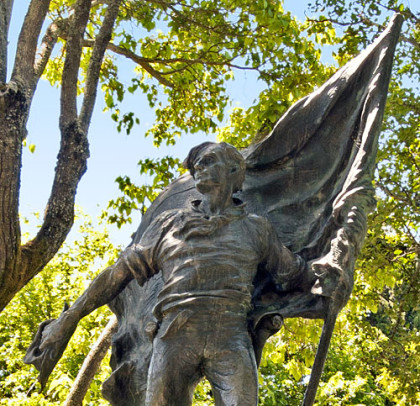Take down public symbols of the Mission system?

New Orleans has recently gone through process to remove symbols of the
Confederacy from public places. For years, such statues and public
symbols stood with tacit acceptance by the powers that be, in New
Orleans and the South, while the victims of the Confederacy had no
public statues or symbols to recognize or interpret the full scope of
the region’s history.
Sonoma has a similar pattern. The Bear Flag statue, the coming Vallejo statue, the Manifest Destiny painting in the Depot Park museum, and school curricula on California Missions, all in tacit ways, romanticize and sanitize a history that is very similar to the Confederacy, a history fraught with terror, violence and suffering.
In Sonoma and California, the Mission system was a cruel and violent subjugation of native peoples. This history is frequently relegated to small and inadequate interpretive lead-in, with a few baskets and arrowheads, and a drawing of Indians tending livestock or making a chapel. As interpretation goes forward in exhibits, Manifest Destiny is glorified, as de facto, unquestioned US mythical ground. Manifest Destiny and its derivation with Puritan Providence, the shining city on the hill, remains today with adherence to notions of American exceptionalism. Exceptionalism is a refusal to understand other cultures, and cultural history, on their own relative terms.
The Mission system and Manifest Destiny were both religion-justified conquests. Fate and Destiny were given by God, as land and people for the taking. This justification remains with public symbols that tacitly support the conquest.
Reflecting Puritan presumptions, Richard Henry Dana said, “what an enterprising people could do with this land.” Then came the Chinese, who on the 1860 Sonoma Census were nearly all noted as “John Chinaman.” And then followed the Chinese Exclusion Act, one step in many dark national chapters of nativism; another chapter seen now with Trump’s immigration executive orders to deport 12 million “bad hombres.”
Local Sonoma history presents the tremendous wake of suffering and violence experienced by native peoples, and immigrants, as an afterthought; it’s minimized. Sonoma today remains a white, segregated community, protective of its sanitized myths, even as the Spanish conquest lives on with mixed-race descendants who live apart, as servants, and “illegals.” History is often enough seen as a façade, as somehow a property of a building, and not the past social fabric that made it.
Acknowledging Sonoma’s full history does not erase or deny. All true cards are simply laid on the table in an honest assessment of what has already been done. Yet should we purge ourselves of unjust symbols, and not address lingering injustices now, in current reflections of history both good and bad, we fail to rise to be true historians, and citizens today.
The following are 12 memorable lines from New Orleans mayor Mitch Landrieu’s speech as the statue of Robert E. Lee was removed from a pedestal. These statements could equally well apply to one made here in Sonoma during the removal of the Bear Flag statue, and to refuse the new Vallejo statue, and insist on accurate public interpretation of the full historical scope of what the Mission system and Manifest Destiny have wrought.
1. “There is a difference between remembrance of history and reverence of it.”
2. “These statues are not just stone and metal. They are not just innocent remembrances of a benign history. These monuments purposefully celebrate a fictional, sanitized Confederacy; ignoring the death, ignoring the enslavement, and the terror that it actually stood for.”
3. “They were erected purposefully to send a strong message to all who walked in their shadows about who was still in charge in this city. ”
4. “So I am not judging anybody, I am not judging people. We all take our own journey on race.”
5. “I knew that taking down the monuments was going to be tough, but you elected me to do the right thing, not the easy thing, and this is what that looks like.”
6. “This is, however, about showing the whole world that we as a city and as a people are able to acknowledge, understand, reconcile and most importantly, choose a better future for ourselves making straight what has been crooked and making right what was wrong.”
7. “It is an affront to our present, and it is a bad prescription for our future. History cannot be changed. It cannot be moved like a statue. What is done is done.”
8. “Centuries-old wounds are still raw because they never healed right in the first place. Here is the essential truth. We are better together than we are apart.”
9. “If we take these statues down and don’t change to become a more open and inclusive society this would have all been in vain.”
10. “We have not erased history; we are becoming part of the city’s history by righting the wrong image these monuments represent and crafting a better, more complete future for all our children and for future generations.”
11.”Instead of revering a four-year brief historical aberration that was called the Confederacy we can celebrate all 300 years of our rich, diverse history as a place named New Orleans and set the tone for the next 300 years.”
12. “The Confederacy was on the wrong side of history and humanity. It sought to tear apart our nation and subjugate our fellow Americans to slavery. This is the history we should never forget and one that we should never again put on a pedestal to be revered.”
No comments:
Post a Comment